
The total number of possible dichloro derivatives of n-butene are:
(A) 2
(B) 4
(C) 5
(D) 6
Answer
219.6k+ views
Hint: We need to check the position of chlorine with respect to the double bond in the structure of n-butene. As the question is asked about n-butene which means we can place the double bond in three positions with respect to chlorine atoms and no branches will be introduced to the carbon chain. The number of possible structures for n-butene are as follows:

But-1-ene

But-2-ene
Complete Step by Step Solution:
n-Butene or normal butene are considered as the stable compounds but the unsaturated carbon-carbon double bonds which consists of $\pi $ electrons make them more reactive due to the attack of electrophile becomes easy due to the presence of cloud of electrons, as compared to similar alkanes as which are more inert compounds in various ways. As per the number of structures of n-butene, the possible constitutional dichloro derivatives of n-butene are as follows:
a) 1,1-dichlorobut-1-ene
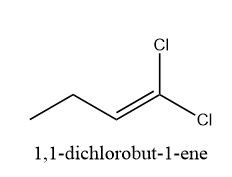
b) 1,1-dichlorobut-2-ene

c) 1,2-dichlorobut-1-ene
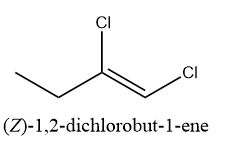
d) 4,4-dichlorobut-1-ene
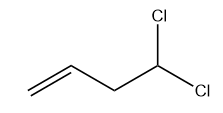
e) 1,3-dichlorobut-2-ene
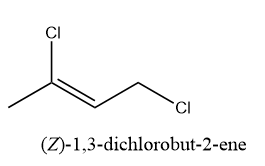
f) 1,3-dichlorobut-1-ene
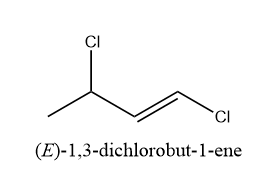
Hence, the total number of possible constitutional dichloro derivatives of n-butene are 6. Therefore, option (D) is the correct answer.
Note: It is important to note that the answer in such questions may vary due to the possibility of stereoisomerism in the compound. So, whenever the question is asked in general, only constitutional isomers of the compound are included. The possible stereoisomers that can be formed in case of alkene are E-Z geometrical isomerism that are similar in molecular structure but differ in arrangement of atoms in space.

But-1-ene

But-2-ene
Complete Step by Step Solution:
n-Butene or normal butene are considered as the stable compounds but the unsaturated carbon-carbon double bonds which consists of $\pi $ electrons make them more reactive due to the attack of electrophile becomes easy due to the presence of cloud of electrons, as compared to similar alkanes as which are more inert compounds in various ways. As per the number of structures of n-butene, the possible constitutional dichloro derivatives of n-butene are as follows:
a) 1,1-dichlorobut-1-ene

b) 1,1-dichlorobut-2-ene

c) 1,2-dichlorobut-1-ene

d) 4,4-dichlorobut-1-ene

e) 1,3-dichlorobut-2-ene

f) 1,3-dichlorobut-1-ene

Hence, the total number of possible constitutional dichloro derivatives of n-butene are 6. Therefore, option (D) is the correct answer.
Note: It is important to note that the answer in such questions may vary due to the possibility of stereoisomerism in the compound. So, whenever the question is asked in general, only constitutional isomers of the compound are included. The possible stereoisomers that can be formed in case of alkene are E-Z geometrical isomerism that are similar in molecular structure but differ in arrangement of atoms in space.
Recently Updated Pages
Chemical Equation - Important Concepts and Tips for JEE

JEE Main 2022 (July 29th Shift 1) Chemistry Question Paper with Answer Key

Conduction Explained: Definition, Examples & Science for Students

Analytical Method of Vector Addition Explained Simply

Atomic Size - Important Concepts and Tips for JEE

JEE Main 2022 (June 29th Shift 1) Maths Question Paper with Answer Key

Trending doubts
JEE Main 2026: Application Form Open, Exam Dates, Syllabus, Eligibility & Question Papers

Derivation of Equation of Trajectory Explained for Students

Hybridisation in Chemistry – Concept, Types & Applications

Understanding the Angle of Deviation in a Prism

Understanding Collisions: Types and Examples for Students

Understanding Atomic Structure for Beginners

Other Pages
NCERT Solutions For Class 12 Chemistry Chapter 1 Solutions - 2025-26

Solutions Class 12 Chemistry Chapter 1 CBSE Notes - 2025-26

NCERT Solutions for Class 12 Chemistry Chapter Chapter 7 Alcohol Phenol and Ether

NCERT Solutions ForClass 12 Chemistry Chapter Chapter 8 Aldehydes Ketones And Carboxylic Acids

JEE Advanced Marks vs Ranks 2025: Understanding Category-wise Qualifying Marks and Previous Year Cut-offs

Haloalkanes and Haloarenes Class 12 Chemistry Chapter 6 CBSE Notes - 2025-26




